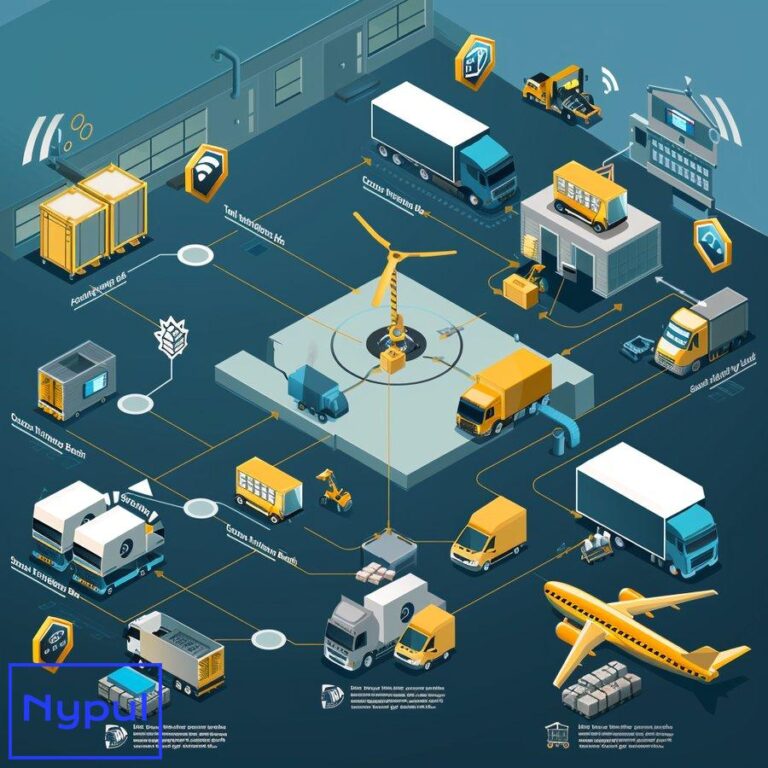What Is Cloud Based Transportation Management System
What are the key features of a cloud-based transportation management system?
A cloud-based transportation management system (TMS) is a sophisticated software solution designed to streamline and optimize logistics operations. This innovative technology leverages cloud computing to provide businesses with powerful tools for managing their transportation processes efficiently and cost-effectively. Let’s delve into the key features that make cloud-based TMS an indispensable asset for modern logistics operations.
Route Optimization
At the heart of any cloud-based TMS lies its route optimization capabilities. This feature utilizes advanced algorithms to determine the most efficient routes for shipments, taking into account various factors such as distance, traffic patterns, and delivery time windows. By optimizing routes, businesses can significantly reduce fuel consumption, minimize transit times, and improve overall operational efficiency.
The route optimization feature typically includes:
- Real-time traffic data integration
- Multi-stop route planning
- Alternative route suggestions
- Fuel consumption estimates
Real-Time Tracking and Visibility
Cloud-based TMS platforms offer real-time tracking and visibility of shipments, providing stakeholders with up-to-the-minute information on the location and status of their cargo. This feature enables businesses to:
- Monitor shipment progress
- Identify potential delays or issues
- Provide accurate ETAs to customers
- Enhance overall supply chain transparency
Real-time tracking is often facilitated through GPS technology and integration with carrier systems, allowing for seamless data exchange and comprehensive visibility across the entire transportation network.
Carrier Management and Selection
Effective carrier management is crucial for optimizing transportation operations. Cloud-based TMS platforms offer robust carrier management features that enable businesses to:
- Maintain a centralized database of carriers
- Compare carrier rates and performance metrics
- Automate carrier selection based on predefined criteria
- Manage carrier contracts and compliance
These capabilities empower businesses to make data-driven decisions when selecting carriers, ensuring they choose the most suitable options for each shipment based on factors such as cost, reliability, and transit times.
Freight Audit and Payment
Cloud-based TMS solutions often include automated freight audit and payment functionalities, which help streamline the financial aspects of transportation management. These features typically encompass:
- Automated invoice matching and verification
- Identification of billing discrepancies
- Electronic payment processing
- Detailed cost allocation and reporting
By automating these processes, businesses can reduce errors, expedite payment cycles, and gain better visibility into their transportation spend.
Analytics and Reporting
Data-driven decision-making is a cornerstone of effective transportation management. Cloud-based TMS platforms offer robust analytics and reporting capabilities that provide valuable insights into various aspects of logistics operations. These features often include:
- Customizable dashboards and reports
- Key performance indicator (KPI) tracking
- Trend analysis and forecasting
- Benchmark comparisons
By leveraging these analytics tools, businesses can identify areas for improvement, optimize their transportation strategies, and make informed decisions to enhance overall performance.
Integration Capabilities
Cloud-based TMS solutions are designed to seamlessly integrate with other enterprise systems and technologies. This integration capability allows for smooth data flow and enhanced collaboration across various business functions. Common integration points include:
- Enterprise Resource Planning (ERP) systems
- Warehouse Management Systems (WMS)
- Customer Relationship Management (CRM) platforms
- Electronic Data Interchange (EDI) systems
These integrations enable businesses to create a cohesive technology ecosystem that supports end-to-end supply chain visibility and efficiency.
Mobile Accessibility
In today’s fast-paced business environment, mobile accessibility is a crucial feature of cloud-based TMS platforms. Mobile apps and responsive web interfaces allow users to access critical transportation information and perform essential tasks from anywhere, at any time. This mobility enables:
- On-the-go decision-making
- Real-time status updates and notifications
- Electronic proof of delivery capture
- Remote access to shipment details and documents
Mobile accessibility ensures that logistics professionals can stay connected and productive, even when they’re away from their desks.
Scalability and Flexibility
Cloud-based TMS solutions offer unparalleled scalability and flexibility, allowing businesses to adapt their transportation management capabilities as their needs evolve. This scalability is facilitated by:
- Pay-as-you-go pricing models
- Easy addition or removal of users and modules
- Automatic software updates and enhancements
- Ability to handle increasing transaction volumes
The flexible nature of cloud-based TMS platforms ensures that businesses can grow and evolve their transportation management capabilities without the need for significant infrastructure investments or system overhauls.
Security and Compliance
Given the sensitive nature of transportation data, cloud-based TMS platforms prioritize security and compliance features to protect businesses and their stakeholders. These features typically include:
- Data encryption and secure transmission protocols
- Role-based access controls
- Compliance with industry standards and regulations
- Regular security audits and updates
By implementing robust security measures, cloud-based TMS solutions provide businesses with peace of mind, knowing that their transportation data is protected against unauthorized access and cyber threats.
Collaborative Tools
Effective transportation management often requires collaboration between various stakeholders, including shippers, carriers, and customers. Cloud-based TMS platforms facilitate this collaboration through features such as:
- Shared dashboards and reports
- Real-time communication tools
- Document sharing and version control
- Collaborative planning and forecasting
These collaborative tools enhance communication, streamline workflows, and foster stronger relationships between all parties involved in the transportation process.
In conclusion, cloud-based transportation management systems offer a comprehensive suite of features designed to optimize logistics operations, enhance visibility, and drive efficiency across the supply chain. By leveraging these key features, businesses can gain a competitive edge in the complex world of transportation management, ultimately leading to improved customer satisfaction and bottom-line results.
How does a cloud-based TMS benefit logistics operations?
Cloud-based Transportation Management Systems (TMS) have revolutionized the way logistics operations are conducted, offering a wide array of benefits that significantly enhance efficiency, reduce costs, and improve overall performance. Let’s explore the numerous advantages that a cloud-based TMS brings to logistics operations.

Cost Reduction
One of the primary benefits of implementing a cloud-based TMS is the substantial cost savings it can generate for logistics operations. These savings are realized through various mechanisms:
Freight Spend Optimization: Cloud-based TMS platforms provide advanced tools for optimizing freight spend. By leveraging data analytics and machine learning algorithms, these systems can identify the most cost-effective shipping options, negotiate better rates with carriers, and consolidate shipments to reduce overall transportation costs.
Operational Efficiency: By automating many manual processes, such as route planning, carrier selection, and invoice processing, cloud-based TMS solutions significantly reduce labor costs and minimize the potential for human error. This increased efficiency allows logistics teams to focus on more strategic tasks, further driving cost savings.
Infrastructure Savings: Unlike traditional on-premise solutions, cloud-based TMS platforms eliminate the need for expensive hardware and IT infrastructure. This shift from capital expenditure (CapEx) to operational expenditure (OpEx) can result in significant cost savings, particularly for small and medium-sized businesses.
Scalability: Cloud-based TMS solutions offer pay-as-you-go pricing models, allowing businesses to scale their usage up or down based on their needs. This flexibility ensures that companies only pay for the resources they use, avoiding unnecessary expenses associated with over-provisioning.
To illustrate the potential cost savings, consider the following table:
| Cost Category | Traditional TMS | Cloud-Based TMS | Potential Savings |
|---|---|---|---|
| Infrastructure | $100,000 | $0 | $100,000 |
| IT Support | $50,000/year | $10,000/year | $40,000/year |
| Software Licenses | $75,000/year | $30,000/year | $45,000/year |
| Freight Spend | $1,000,000/year | $900,000/year | $100,000/year |
| Total Annual Savings | $285,000 |
Enhanced Visibility and Control
Cloud-based TMS solutions provide unparalleled visibility and control over logistics operations, offering real-time insights and actionable data to drive informed decision-making.
Real-Time Tracking: With cloud-based TMS, logistics managers can track shipments in real-time, gaining instant visibility into the location and status of goods in transit. This capability enables proactive problem-solving and allows for timely communication with customers regarding delivery expectations.
Performance Metrics: Cloud-based TMS platforms offer comprehensive analytics and reporting tools that provide valuable insights into key performance indicators (KPIs) such as on-time delivery rates, carrier performance, and transportation costs. These metrics enable logistics teams to identify areas for improvement and make data-driven decisions to optimize operations.
Exception Management: Advanced cloud-based TMS solutions include exception management features that automatically flag potential issues, such as delayed shipments or compliance violations. This proactive approach allows logistics teams to address problems quickly, minimizing disruptions and maintaining high service levels.
Improved Customer Service
The implementation of a cloud-based TMS can significantly enhance customer service in logistics operations, leading to increased satisfaction and loyalty.
Accurate ETAs: By leveraging real-time tracking and advanced analytics, cloud-based TMS platforms can provide customers with highly accurate estimated time of arrival (ETA) information. This transparency helps manage customer expectations and reduces the need for status inquiries.
Self-Service Portals: Many cloud-based TMS solutions offer customer-facing portals that allow clients to access shipment information, track deliveries, and generate reports independently. This self-service capability improves customer satisfaction while reducing the workload on customer service teams.
Proactive Communication: With access to real-time data and automated alerts, logistics teams can proactively communicate with customers about potential delays or issues, demonstrating a commitment to transparency and customer care.
Flexibility and Scalability
Cloud-based TMS solutions offer unparalleled flexibility and scalability, allowing logistics operations to adapt quickly to changing business needs and market conditions.
Rapid Deployment: Unlike traditional on-premise systems, cloud-based TMS platforms can be deployed quickly, often in a matter of weeks rather than months. This rapid implementation allows businesses to start realizing benefits sooner and respond more quickly to market opportunities.
Easy Updates: Cloud-based TMS providers typically handle all software updates and maintenance, ensuring that users always have access to the latest features and security patches without the need for disruptive upgrades or downtime.
Global Accessibility: Cloud-based TMS solutions can be accessed from anywhere with an internet connection, enabling seamless collaboration between geographically dispersed teams and supporting global logistics operations.
Integration Capabilities
Cloud-based TMS platforms are designed to integrate seamlessly with other enterprise systems, creating a cohesive technology ecosystem that supports end-to-end supply chain visibility and efficiency.
ERP Integration: By integrating with Enterprise Resource Planning (ERP) systems, cloud-based TMS solutions can automate data exchange, streamline order processing, and provide a unified view of business operations.
WMS Integration: Integration with Warehouse Management Systems (WMS) enables seamless coordination between transportation and warehousing operations, optimizing inventory management and order fulfillment processes.
EDI Capabilities: Cloud-based TMS platforms often include built-in Electronic Data Interchange (EDI) capabilities, facilitating smooth communication and data exchange with carriers, customers, and other supply chain partners.
Improved Carrier Management
Effective carrier management is crucial for optimizing logistics operations, and cloud-based TMS solutions offer powerful tools to streamline this process.
Carrier Selection: Cloud-based TMS platforms provide advanced carrier selection capabilities, allowing logistics teams to compare rates, transit times, and performance metrics to choose the best carrier for each shipment.
Performance Tracking: By collecting and analyzing carrier performance data, cloud-based TMS solutions enable logistics managers to identify top-performing carriers and address issues with underperforming partners.
Automated Tendering: Many cloud-based TMS platforms offer automated tendering capabilities, streamlining the process of assigning shipments to carriers based on predefined rules and preferences.
Enhanced Compliance and Risk Management
Cloud-based TMS solutions help logistics operations maintain compliance with industry regulations and manage risk more effectively.
Regulatory Compliance: These systems often include built-in compliance checks and documentation management features, ensuring that all shipments meet relevant regulatory requirements, such as hazardous materials handling or international trade regulations.
Security Measures: Cloud-based TMS providers typically implement robust security measures, including data encryption, regular backups, and disaster recovery plans, to protect sensitive logistics information and mitigate cybersecurity risks.
Audit Trails: Comprehensive audit trails and reporting capabilities in cloud-based TMS platforms support compliance efforts and provide valuable documentation for internal and external audits.
Environmental Sustainability
As businesses increasingly focus on reducing their environmental impact, cloud-based TMS solutions offer several benefits that support sustainability initiatives in logistics operations.
Route Optimization: By optimizing routes and consolidating shipments, cloud-based TMS platforms help reduce fuel consumption and greenhouse gas emissions associated with transportation activities.
Modal Shift Analysis: Advanced TMS solutions can analyze shipping patterns and suggest opportunities for modal shifts (e.g., from road to rail) that can further reduce environmental impact while potentially lowering costs.
Carbon Footprint Reporting: Many cloud-based TMS platforms now include features for calculating and reporting on the carbon footprint of transportation activities, supporting corporate sustainability reporting and goal-setting efforts.
In conclusion, the benefits of implementing a cloud-based TMS in logistics operations are far-reaching and impactful. From cost reduction and enhanced visibility to improved customer service and environmental sustainability, these advanced systems provide a competitive edge in today’s complex and dynamic logistics landscape. By leveraging the power of cloud computing and advanced analytics, businesses can transform their logistics operations, driving efficiency, reducing costs, and ultimately delivering superior value to their customers.
In what ways does a cloud-based TMS differ from traditional systems?
Cloud-based Transportation Management Systems (TMS) represent a significant evolution from traditional, on-premise TMS solutions. These modern platforms leverage cloud computing technology to offer a range of advantages that set them apart from their predecessors. Let’s explore the key differences between cloud-based TMS and traditional systems across various aspects of implementation, functionality, and user experience.

Deployment and Implementation
The deployment and implementation process is one of the most striking differences between cloud-based TMS and traditional systems.
Cloud-Based TMS:
– Rapid Deployment: Cloud-based TMS solutions can typically be implemented in a matter of weeks, allowing businesses to quickly leverage the system’s benefits.
– Minimal Hardware Requirements: These systems require no on-site hardware installation, as they operate entirely in the cloud.
– Automatic Updates: Software updates and new features are automatically pushed to users, ensuring they always have access to the latest functionality.
– Scalability: Cloud-based systems can easily scale up or down to accommodate changing business needs without significant infrastructure changes.
Traditional TMS:
– Lengthy Implementation: On-premise TMS solutions often require months of planning, installation, and configuration before they are fully operational.
– Significant Hardware Investment: Traditional systems typically require substantial investments in on-site servers and networking equipment.
– Manual Updates: Software updates often need to be manually installed, which can be time-consuming and may require system downtime.
– Limited Scalability: Scaling traditional systems often requires additional hardware purchases and complex reconfigurations.
Cost Structure
The cost structure of cloud-based TMS differs significantly from that of traditional systems, impacting both initial investment and ongoing expenses.
Cloud-Based TMS:
– Subscription-Based Pricing: Cloud-based TMS solutions typically follow a Software-as-a-Service (SaaS) model with monthly or annual subscription fees.
– Lower Upfront Costs: Initial investment is minimal, as there’s no need for expensive hardware or extensive IT infrastructure.
– Predictable Expenses: Subscription-based pricing allows for more accurate budgeting and forecasting of TMS-related expenses.
– Included Maintenance: Software updates, security patches, and general maintenance are typically included in the subscription fee.
Traditional TMS:
– High Initial Investment: On-premise systems often require significant upfront costs for software licenses, hardware, and implementation services.
– Unpredictable Maintenance Costs: Ongoing maintenance, updates, and potential hardware replacements can lead to unpredictable expenses.
– IT Staff Requirements: Traditional systems may necessitate dedicated IT staff for maintenance and support, adding to overall costs.
To illustrate the cost differences, consider the following comparison table:
| Cost Category | Traditional TMS | Cloud-Based TMS |
|---|---|---|
| Initial Software License | $100,000 – $500,000 | $0 (included in subscription) |
| Hardware Costs | $50,000 – $200,000 | $0 |
| Implementation Services | $50,000 – $250,000 | $10,000 – $50,000 |
| Annual Maintenance | 15-20% of license cost | Included in subscription |
| IT Staff (Annual) | $80,000 – $150,000 | Minimal to none |
| Annual Subscription | N/A | $20,000 – $100,000 |
Accessibility and Mobility
The way users access and interact with the TMS is another key differentiator between cloud-based and traditional systems.
Cloud-Based TMS:
– Anytime, Anywhere Access: Users can access the system from any device with an internet connection, enabling remote work and on-the-go management.
– Mobile-Friendly Interfaces: Many cloud-baseCloud-Based TMS (continued):
- Mobile-Friendly Interfaces: Many cloud-based TMS solutions offer dedicated mobile applications or responsive web designs, allowing users to manage transportation tasks and access critical information from smartphones and tablets.
- Real-Time Collaboration: Cloud-based systems facilitate real-time collaboration among team members, carriers, and customers, enhancing communication and decision-making.
Traditional TMS:
– Limited Access: Traditional systems often require users to be on-site or connected to a specific network to access the software, limiting flexibility.
– Desktop-Centric Interfaces: Many on-premise solutions are designed primarily for desktop use, making it challenging to manage logistics operations while away from the office.
Integration Capabilities
Integration with other systems is a crucial factor in the effectiveness of a TMS. Cloud-based TMS platforms generally offer superior integration capabilities compared to traditional systems.
Cloud-Based TMS:
– Pre-Built Integrations: Many cloud-based TMS solutions come with pre-built integrations for popular ERP, WMS, and CRM systems, simplifying the connection process.
– API Accessibility: Cloud-based platforms often provide robust APIs that allow for easy customization and integration with other software applications.
– Continuous Updates: As cloud providers update their systems, integration capabilities can also improve without requiring significant user intervention.
Traditional TMS:
– Manual Integrations: Integrating traditional systems with other software often requires custom development work, which can be time-consuming and costly.
– Rigid Architecture: On-premise solutions may have limitations in terms of integration flexibility due to their older architecture and design.
User Experience and Interface
The user experience (UX) and interface design of a TMS can significantly impact its usability and effectiveness.
Cloud-Based TMS:
– Intuitive Interfaces: Modern cloud-based TMS platforms are designed with user-friendly interfaces that prioritize ease of use and accessibility.
– Customizable Dashboards: Users can often customize their dashboards to display the most relevant information and KPIs for their specific roles.
– Enhanced User Training: Many cloud-based providers offer extensive training resources, including online tutorials, webinars, and customer support.
Traditional TMS:
– Steeper Learning Curve: On-premise solutions may have outdated interfaces that are less intuitive, leading to longer training times for new users.
– Limited Customization: Customization options for dashboards and reports may be restricted in traditional systems, reducing user satisfaction.
Security and Compliance
Security measures differ significantly between cloud-based TMS solutions and traditional systems, impacting data protection and compliance efforts.
Cloud-Based TMS:
– Advanced Security Protocols: Cloud providers typically implement robust security measures such as data encryption, multi-factor authentication, and regular security audits.
– Compliance Management: Many cloud-based TMS platforms include built-in compliance features that help businesses adhere to industry regulations and standards.
– Data Redundancy: Cloud providers often have data redundancy measures in place to protect against data loss due to hardware failures or disasters.
Traditional TMS:
– Variable Security Standards: The security measures implemented by traditional systems can vary widely based on the organization’s resources and expertise.
– Manual Compliance Efforts: Ensuring compliance with regulations may require significant manual effort in traditional systems, increasing the risk of errors.
In summary, cloud-based Transportation Management Systems offer a range of advantages over traditional on-premise solutions. From rapid deployment and cost savings to enhanced accessibility, integration capabilities, user experience, and security features, cloud-based TMS platforms are transforming logistics operations. By embracing this technology, businesses can improve efficiency, reduce costs, and gain a competitive edge in today’s dynamic supply chain landscape.
How can a cloud-based TMS integrate with other technologies?
A cloud-based Transportation Management System (TMS) is designed to be an integral part of a broader logistics ecosystem. Its ability to integrate seamlessly with other technologies enhances its functionality and effectiveness. This section explores the various ways a cloud-based TMS can integrate with other technologies to optimize logistics operations.
Enterprise Resource Planning (ERP) Systems
Integrating a cloud-based TMS with an ERP system is one of the most common practices in logistics management. This integration allows for streamlined data flow between transportation management and other business functions such as finance, inventory management, and order processing.
Benefits of ERP Integration:
-
Automated Data Exchange: Integration eliminates manual data entry by automating the exchange of information between the TMS and ERP system. This reduces errors and saves time.
-
Unified Reporting: Businesses can generate comprehensive reports that include transportation costs alongside other operational metrics, providing a holistic view of performance.
-
Improved Order Fulfillment: Real-time visibility into inventory levels enables better coordination between transportation planning and inventory management.
Common ERP Systems Integrated with Cloud-Based TMS:
| ERP System | Description |
|---|---|
| SAP | A leading enterprise software provider known for its comprehensive ERP solutions. |
| Oracle NetSuite | A cloud-based ERP solution that offers integrated financials, CRM, and eCommerce capabilities. |
| Microsoft Dynamics 365 | A suite of intelligent business applications that includes ERP functionalities tailored for various industries. |
Warehouse Management Systems (WMS)
Integrating a cloud-based TMS with a Warehouse Management System (WMS) enhances coordination between transportation and warehousing operations. This integration ensures that inventory levels are accurately reflected in real-time across both systems.
Benefits of WMS Integration:
-
Streamlined Order Processing: Improved communication between the WMS and TMS allows for faster order processing by ensuring that shipments are prepared based on real-time demand data.
-
Enhanced Inventory Visibility: Real-time updates on inventory levels help logistics teams make informed decisions about replenishing stock or adjusting shipping schedules.
-
Optimized Labor Management: Integration enables better workforce planning by aligning labor needs in the warehouse with transportation schedules.
Common WMS Solutions Integrated with Cloud-Based TMS:
| WMS Solution | Description |
|---|---|
| Manhattan Associates | A leading provider of supply chain software solutions that optimize warehouse operations. |
| Blue Yonder | A comprehensive supply chain platform offering advanced WMS capabilities. |
| Fishbowl Warehouse | An inventory management solution designed for small to medium-sized businesses. |
Customer Relationship Management (CRM) Systems
Integrating a cloud-based TMS with Customer Relationship Management (CRM) systems enhances customer service by providing logistics teams with valuable insights into customer preferences and behaviors.
Benefits of CRM Integration:
-
Personalized Customer Service: Access to customer data allows logistics teams to tailor their services based on individual customer needs.
-
Improved Communication: Integration facilitates better communication between sales teams and logistics operations, ensuring timely updates regarding order statuses.
-
Enhanced Reporting Capabilities: Combining transportation data with customer insights enables businesses to analyze trends in customer behavior related to shipping preferences.
Common CRM Solutions Integrated with Cloud-Based TMS:
| CRM Solution | Description |
|---|---|
| Salesforce | A leading CRM platform that offers extensive customization options for managing customer relationships. |
| HubSpot | An inbound marketing platform that includes CRM functionalities tailored for small businesses. |
| Zoho CRM | A cost-effective CRM solution designed for small to medium-sized enterprises. |
Electronic Data Interchange (EDI)
Electronic Data Interchange (EDI) facilitates the electronic exchange of business documents between trading partners in a standardized format. Integrating EDI capabilities within a cloud-based TMS streamlines communication with carriers, suppliers, and customers.
Benefits of EDI Integration:
-
Reduced Paperwork: EDI eliminates the need for physical documents by automating transactions such as purchase orders, invoices, and shipping notices.
-
Faster Transaction Processing: Automated document exchange speeds up transaction processing times and reduces delays associated with manual handling.
-
Improved Accuracy: EDI minimizes errors associated with manual data entry by standardizing document formats across trading partners.
Common EDI Providers Integrated with Cloud-Based TMS:
| EDI Provider | Description |
|---|---|
| SPS Commerce | A leading provider of EDI services that offers comprehensive solutions for supply chain collaboration. |
| TrueCommerce | An EDI provider specializing in connecting businesses through integrated supply chain solutions. |
| Cleo Integration Cloud | A platform offering secure file transfer capabilities along with EDI integration services. |
Internet of Things (IoT)
The Internet of Things (IoT) refers to interconnected devices that collect and exchange data over the internet. Integrating IoT technology within a cloud-based TMS enhances visibility into transportation operations by providing real-time data on shipment conditions.
Benefits of IoT Integration:
-
Real-Time Monitoring: IoT sensors enable real-time monitoring of shipment conditions such as temperature, humidity, and location during transit.
-
Predictive Analytics: Data collected from IoT devices can be analyzed to predict potential issues before they occur, allowing logistics teams to take proactive measures.
-
Enhanced Supply Chain Visibility: IoT integration provides stakeholders with comprehensive insights into the entire supply chain process from origin to destination.
Common IoT Applications Integrated with Cloud-Based TMS:
| IoT Application | Description |
|---|---|
| GPS Tracking Devices | Devices used for real-time location tracking of shipments during transit. |
| Temperature Sensors | Sensors used for monitoring temperature-sensitive shipments such as pharmaceuticals or perishables. |
| RFID Technology | Radio-frequency identification technology used for tracking inventory movement within warehouses or during transit. |
In conclusion, integrating a cloud-based Transportation Management System with various technologies enhances its functionality while optimizing logistics operations. By leveraging integrations with ERP systems, WMS solutions, CRM platforms, EDI services, and IoT applications, businesses can achieve greater efficiency, improved visibility across their supply chains, enhanced customer service capabilities, and ultimately drive better decision-making processes throughout their logistics networks.
What are the essential steps for implementing a cloud-based TMS?

Implementing a cloud-based Transportation Management System (TMS) is a strategic initiative that can significantly enhance logistics operations. However, successful implementation requires careful planning and execution across several key steps. Below are the essential steps involved in implementing a cloud-based TMS effectively.
Step 1: Define Objectives
Before initiating the implementation process, it is crucial to define clear objectives aligned with your organization’s overall business goals. Consider the following aspects:
-
Identify specific pain points within your current transportation management processes.
-
Determine what you aim to achieve through implementing a cloud-based TMS (e.g., cost reduction, improved visibility).
-
Establish measurable key performance indicators (KPIs) to assess success post-implementation.
Step 2: Assemble an Implementation Team
Creating an effective implementation team is vital for ensuring all aspects of the project are covered. The team should include representatives from various departments such as:
- Logistics/Transportation
- IT/Technology
- Finance/Accounting
- Sales/Customer Service
This cross-functional team will help ensure diverse perspectives are considered throughout the implementation process.
Step 3: Select the Right Cloud-Based TMS Provider
Choosing the right cloud-based TMS provider is one of the most critical decisions in the implementation process. Consider these factors when evaluating potential providers:
Provider Evaluation Criteria
- Features & Functionality
-
Ensure that the chosen system offers features that align with your defined objectives.
-
Integration Capabilities
-
Assess how well the provider’s solution integrates with existing systems such as ERP or WMS.
-
User Experience
-
Evaluate user interface design; an intuitive interface will facilitate easier adoption by staff members.
-
Customer Support
-
Investigate available support options including training resources during implementation as well as ongoing assistance post-launch.
-
Cost Structure
- Understand pricing models including subscription fees versus additional costs associated with implementation or upgrades.
Step 4: Develop an Implementation Plan
Once you have selected a provider, develop a detailed implementation plan outlining key milestones along with timelines for each phase of deployment:
Key Components of an Implementation Plan
- Project Timeline
-
Establish deadlines for each phase including preparation activities through final rollout.
-
Resource Allocation
-
Identify required resources including personnel time commitments from different departments involved in implementation tasks.
-
Risk Assessment
-
Conduct risk assessments identifying potential challenges during implementation along with mitigation strategies if issues arise later on during deployment phases.
-
Change Management Strategy
- Develop strategies addressing resistance towards change among staff members; this might involve training sessions aimed at familiarizing them with new workflows introduced by using this technology effectively moving forward into operations after launch day arrives!
Step 5: Data Migration
Data migration is a critical step in transitioning from legacy systems or manual processes into your new cloud-based environment effectively without losing valuable historical information necessary for operational continuity moving forward!
Key Considerations During Data Migration
- Data Cleanup
-
Before migrating data into your new system ensure it’s accurate; remove duplicates while validating entries against existing records maintained elsewhere within organization prior transferring anything over!
-
Mapping Fields
-
Map fields from legacy databases onto corresponding fields within new platform ensuring consistency throughout dataset transferred successfully without errors occurring later down line once operational use begins!
-
Testing Migration Process
- Conduct thorough testing before finalizing migration; run pilot tests transferring smaller datasets first verifying results before proceeding full-scale transfer across all relevant datasets needed operationally going forward!
Step 6: User Training
Training users on how best utilize features offered by newly implemented system ensures they feel confident using it daily post-launch!
Training Strategies
- Hands-On Workshops
-
Conduct hands-on workshops where users can practice using system features under guidance from knowledgeable trainers familiarized beforehand themselves already!
-
Online Resources
-
Provide access online resources including video tutorials covering common tasks performed regularly within platform encouraging self-paced learning opportunities available anytime needed later down line too!
-
Ongoing Support
- Establish channels through which employees can seek assistance when encountering challenges utilizing new technology; this might involve creating dedicated help desk tickets resolving issues quickly minimizing disruptions productivity levels overall!
Step 7: Go Live
Once all preparations have been completed successfully—including successful migration testing—it’s time officially launch your new cloud-based Transportation Management System!
Key Considerations During Go-Live Phase
- Final Checks
-
Conduct last-minute checks ensuring everything functions correctly before making system live! Confirm all integrations work seamlessly too!
-
Communication Plan
-
Communicate go-live date clearly across organization ensuring everyone understands what changes will occur how they’ll impact daily workflows moving forward!
-
Monitor Performance Post Launch
- Closely monitor performance immediately after launch addressing any issues promptly while gathering feedback from users regarding their experiences utilizing new platform adjusting processes accordingly where necessary improving efficiency continuously over time!
Step 8: Continuous Improvement
Implementing a cloud-based TMS is not just about launching it; ongoing evaluation against defined objectives must occur regularly post-launch!
Continuous Improvement Strategies
- Performance Reviews
-
Schedule regular performance reviews assessing whether KPIs established earlier remain met; adjust strategies accordingly if needed!
-
User Feedback Sessions
-
Hold periodic feedback sessions allowing users share experiences encountered while utilizing system highlighting areas needing improvement further enhancing overall satisfaction levels experienced throughout organization!
-
Stay Updated on New Features
- Keep abreast developments made within chosen platform regularly updating users about new features released enhancing functionality available overall improving efficiency achieved through utilization continuously evolving over time!
In conclusion, implementing a cloud-based Transportation Management System involves several essential steps ranging from defining objectives through continuous improvement efforts following launch day itself! By carefully navigating each stage outlined above organizations can maximize benefits derived from adopting this innovative technology ultimately leading enhanced operational efficiencies driving success long-term future ahead!
What are some real-world applications of cloud-based TMS in businesses?
Cloud-based Transportation Management Systems (TMS) have found widespread adoption across various industries due to their ability to streamline logistics operations efficiently while enhancing visibility throughout supply chains! Here we explore several real-world applications showcasing how different businesses leverage these advanced technologies effectively achieving significant improvements operationally!
![]()
Retail Industry
The retail industry has embraced cloud-based TMS solutions extensively enabling retailers manage complex distribution networks efficiently while improving customer service levels significantly!
Example Application
A major retail chain utilizes a cloud-based TMS platform integrating it seamlessly into existing ERP infrastructure allowing them optimize routing decisions based on real-time traffic conditions reducing delivery times significantly!
Benefits Realized Include:
- Improved On-Time Delivery Rates
- Enhanced Customer Satisfaction Levels
- Reduced Transportation Costs Through Optimized Routing Decisions
Manufacturing Sector
Manufacturers often face challenges managing inbound/outbound shipments efficiently due high volumes produced daily requiring effective coordination across multiple suppliers/distributors involved throughout production processes!
Example Application
A large automotive manufacturer implements a cloud-based TMS solution capable handling high volumes shipments efficiently coordinating deliveries among various suppliers ensuring parts arrive just-in-time production schedules maintained smoothly without delays impacting overall output negatively!
Benefits Realized Include:
- Streamlined Supply Chain Operations
- Increased Production Efficiency Through Timely Deliveries
- Reduced Inventory Holding Costs
Food & Beverage Industry
The food & beverage industry relies heavily upon efficient transportation management ensuring perishable goods reach consumers quickly maintaining quality standards expected throughout distribution channels!
Example Application
A national food distributor employs a cloud-based TMS enabling them track temperature-sensitive shipments closely utilizing IoT sensors integrated directly into platform providing real-time monitoring conditions maintained during transit ensuring compliance regulations governing safety standards adhered strictly at all times!
Benefits Realized Include:
- Enhanced Product Quality Assurance
- Improved Compliance With Regulatory Standards
- Increased Efficiency In Managing Perishable Goods
Pharmaceutical Industry
Pharmaceutical companies must navigate complex regulatory environments while ensuring timely delivery critical medications patients rely upon daily!
Example Application
A global pharmaceutical company adopts a cloud-based TMS integrated directly into its existing supply chain management system allowing them maintain strict compliance requirements while optimizing routing decisions based upon patient needs enhancing overall service levels provided consistently across regions served globally!
Benefits Realized Include:
- Improved Regulatory Compliance Through Enhanced Tracking Capabilities
- Increased Patient Satisfaction Levels Due Timely Deliveries Of Critical Medications
- Streamlined Operations Reducing Costs Associated With Delays
E-Commerce Sector
E-commerce businesses face unique challenges managing vast numbers orders processed daily requiring efficient fulfillment strategies implemented effectively utilizing advanced technologies available today!
Example Application
An online retailer utilizes a robust cloud-based TMS solution capable handling high volumes orders efficiently integrating seamlessly into existing e-commerce platforms providing customers accurate tracking information orders placed improving transparency throughout fulfillment process enhancing overall shopping experience enjoyed customers engaging site regularly returning repeat purchases made easily accessible anytime anywhere desired!
Benefits Realized Include:
- Increased Customer Loyalty Through Enhanced Shopping Experiences
- Reduced Order Processing Times Leading Faster Deliveries Achieved Overall!
3 Increased Operational Efficiency Allowing More Orders Fulfilled Daily Without Compromising Quality Standards Expected Customers Engaging Regularly With Brand Name Recognized Widely Across Markets Served Globally Today!
In summary ,real-world applications showcasing effectiveness achieved through leveraging innovative technologies like those offered via modern-day Cloud-Based Transportation Management Systems demonstrate immense potential available today across diverse industries ranging Retail Manufacturing Food & Beverage Pharmaceutical E-Commerce sectors alike ! By adopting these advanced tools organizations can streamline their logistics operations ultimately driving enhanced efficiencies leading improved service levels delivered consistently customers served worldwide continuously evolving marketplace demands faced daily ahead!






